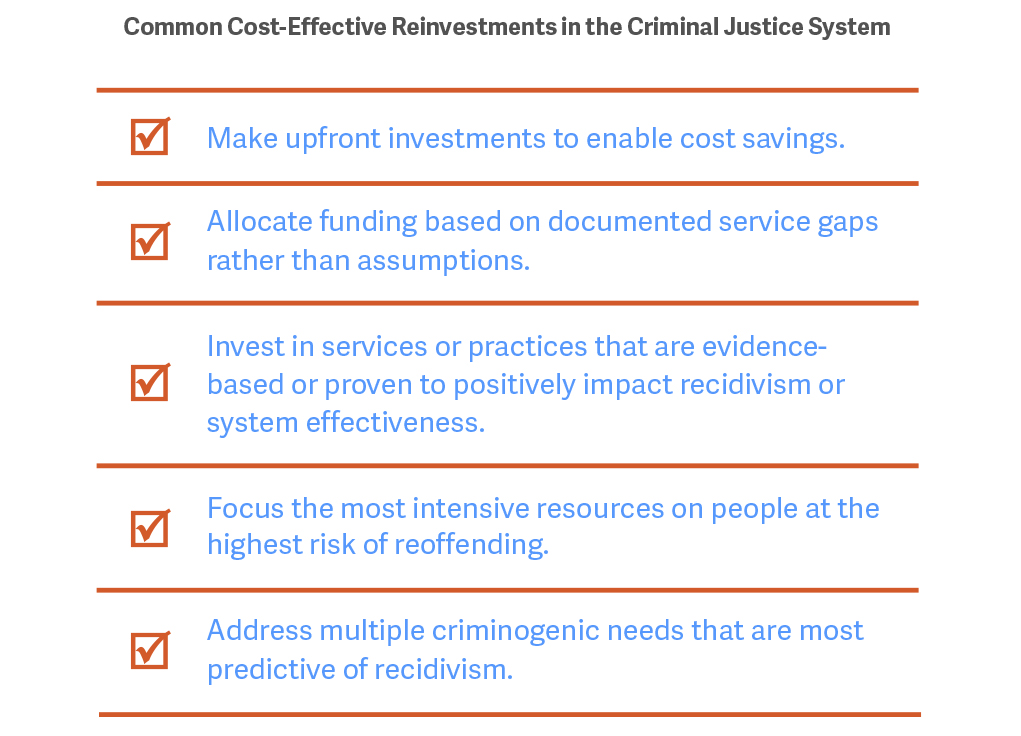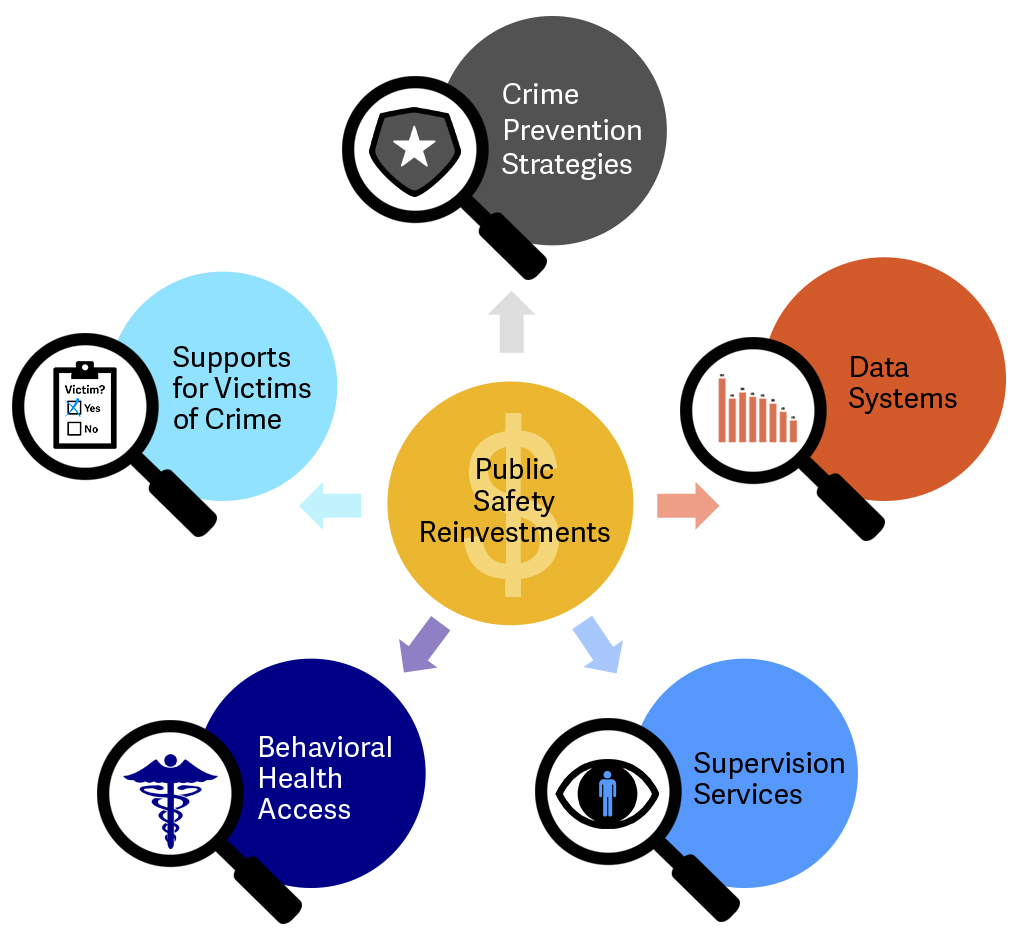Part 3, Strategy 3
Action Item 1: Identify funding priorities and allocate resources accordingly.
Why it matters
After identifying drivers of correctional populations and costs and developing policies to generate savings or avert costs as described in Part 3, Strategy 1 and Strategy 2, state policymakers need to determine how they will shift funding to maximize their investment in public safety.
State policy changes alone aren’t enough to control corrections costs and protect public safety—budgetary decisions must be aligned to support successful implementation of those policies. For example, states often need to invest in training staff, upgrading data systems, strengthening existing services, or creating new ones in order for policy changes to be successful.
Further, state policymakers need to account for how statewide policy changes can impact local governments. For example, policies to prioritize use of costly prison beds for people convicted of serious and repeat offenses could result in more sentences to community-based supervision or local jails. States may need to provide funding to minimize the impact of these policy changes on local governments.
In addition to investing in the implementation of policy changes, states may also need to invest in underfunded areas or other efforts to help local governments improve public safety. Many states recognize that by funding notification systems and improving restitution collection, tracking, and distribution they can ensure that victims are safe and have access to help. States may also invest in pretrial services to help ensure that only people who are a public safety or flight risk are incarcerated pretrial or in policing strategies to reduce crime and violence and increase trust in communities heavily impacted by crime and incarceration.
States need to ensure that their investments have the maximum impact on improving public safety. Data and research-driven decision making can assist states in making smart investments. By assessing gaps in services, states can prioritize funding decisions based on state and local need. Further, states need to ensure they are funding services or practices that data and research show can reduce recidivism, repair harm, prevent crime, build trust, and improve the efficiency and effectiveness of the criminal justice system. States also need to continually assess the effectiveness of their investments and make adjustments as necessary.
What it looks like
- Prioritize funding for measures needed to ensure effective policy implementation, such as hiring and training staff, upgrading data systems, and expanding services.
- See Case Study: States reinvest in strengthening supervision
- See Case Study: States reinvest millions to expand access to behavioral health treatment
- Analyze the impact of policy changes and reinvestments on agencies, courts, and local governments, and provide funding as needed to minimize any negative impact.
- See Case Study: States evaluate the impact of state policies on counties
- Invest in underfunded areas or other efforts needed to increase public safety.
- See Case Study: States reinvest in supporting victims of crime
- Require reinvestments to support implementation of evidence-based practices.
- See Case Study: Oklahoma reinvests in effective law enforcement strategies to reduce crime
Key questions to guide action
- As your state adopts policy changes, what areas of the criminal justice system need further investment for the policy changes to achieve desired results?
- Will state policy changes negatively impact local governments? If so, how can your state adjust policy or provide funding to ameliorate those impacts?
- Which public safety needs have been underfunded in recent years?
Use the information that follows to inform your answers to these questions.
With strategic and targeted reinvestments, states can maximize the effectiveness of policy changes.

By assessing their needs, states can determine which agencies, programs, and services receive reinvestment funding to further public safety goals.

Case Study
States reinvest in strengthening supervision
States have taken varying approaches to ensure that supervision officers have the necessary training and capacity to supervise people effectively. Of the 22 states that have participated in JRI, 12 have reinvested $154 million between 2010 and 2017 in community supervision resources.[49]
- Some states set requirements in statute for supervision staff to be trained on core evidence-based practices proven to change behavior. For instance, Idaho requires in statute that supervision officers receive training on a range of topics, including assessment techniques; risk-reduction and intervention strategies; effective communication skills; and application of cognitive behavioral interventions, reinforcements, and use of authority. To meet the statutory requirement, Idaho reinvested nearly $1.8 million in training between FY2015 and FY2018.[50]
- Sometimes states need to hire additional officers so that officers can focus on people who are most likely to reoffend. For example, after enacting legislation in 2011 that requires everyone leaving prison who is convicted of a felony to receive post-release supervision, North Carolina invested more than $40 million between FY2013 and FY2016 to hire 175 supervision officers.[51]
- In states where probation is a local function, states can support efforts to strengthen supervision and reduce recidivism. Ohio reinvested $44 million between 2012 and 2017 in grants to support local probation departments in reducing probation violations and revocations to prison.[52]
[49] Jeremy Welsh-Loveman and Samantha Harvell, “Justice Reinvestment Initiative Data Snapshot.”
[50] Idaho Department of Corrections, Justice Reinvestment in Idaho: Impact on the State.
[51] North Carolina Department of Public Safety, Justice Reinvestment Performance Measures FY2015–FY2016 (Raleigh, NC: North Carolina Department of Public Safety, 2017).
[52] Jeremy Welsh-Loveman and Samantha Harvell, “Justice Reinvestment Initiative Data Snapshot.”
Case Study
States reinvest millions to expand access to behavioral health treatment
States have reinvested millions of dollars annually to expand access to behavioral health treatment for people on supervision. Between 2010 and 2017, of the 22 states that participated in JRI, 19 have reinvested $156 million in community-based treatment and services.[53]
- Kansas invested $10 million between FY2013 and FY2016 in community-based behavioral health treatment for people on supervision.[54]
- Kentucky reinvested almost $26 million between 2011 and 2017 in community-based behavioral health treatment and services.[55]
- Wisconsin reinvested $10 million annually between FY2010 and FY2017 to expand community-based recidivism-reduction programs, such as substance addiction and mental health treatment and employment services.[56]
[53] Jeremy Welsh-Loveman and Samantha Harvell, “Justice Reinvestment Initiative Data Snapshot.”
[54] Ibid.
[55] Ibid.
[56] Annual funding is appropriated to Wisconsin’s Becky Young Community Corrections: Recidivism Reduction Community Services.
Case Study
States evaluate the impact of state policies on counties
States have taken a range of approaches to ensure that state policies do not negatively impact local governments. In addition to changing policies to reduce the burden on local governments, states have provided funding to local governments to ensure counties have the capacity to house people with short sentences in jails, have the resources to provide treatment, and can support victims of crime.
- Nebraska established a $500,000 grant program in 2015 that gives counties the opportunity to receive financial assistance if the implementation of Justice Reinvestment legislation results in an increase in the average daily population of the county jail.
- North Carolina established a fund in 2011 to compensate counties for housing people convicted of misdemeanors who previously would have gone to prison.
- Oregon created a dashboard to show Justice Reinvestment grant funding by county and type of services. Between 2013 and 2019, the state provided more than $96 million to county governments for housing, reentry programs, treatment, victim services, jail sanctions, and program management and support.[57]
- Utah reinvested more than $4 million in grants to counties to pay for personnel to conduct risk and needs assessments upon booking into jails and to purchase supplies and equipment.[58]
[57] Jeremy Welsh-Loveman and Samantha Harvell, “Justice Reinvestment Initiative Data Snapshot”; for additional details on Oregon’s reinvestment, see http://www.oregon.gov/cjc/data/Pages/jri.aspx.
[58] Utah Office of the Legislative Fiscal Analyst, “Remaining Budget Needs of the Justice Reinvestment Initiative,” (Salt Lake City, UT: Utah Office of the Legislative Fiscal Analyst, 2017).
Case Study
States reinvest in supporting victims of crime
Some states are taking steps to increase restitution collected from people who commit crimes and update victim compensation programs. Some states are also reinvesting in victims’ services.
- Alabama expanded victim notification regarding releases from prison and invested $600,000 in FY2016 and FY2017 to complete the development and implementation of the state’s electronic victim notification system.
- Oregon reinvested more than $11.5 million between FY2013 and FY2017 in programs to expand trauma-informed practices, reduce cultural barriers to services, and improve outreach to victims.[59]
- Pennsylvania reinvested more than $3.7 million between FY2013–14 and FY2017–18 in expanding victim services, notification, and data collection.[60]
[59] Jeremy Welsh-Loveman and Samantha Harvell, “Justice Reinvestment Initiative Data Snapshot.”
[60] Correspondence between CSG Justice Center staff and Pennsylvania Department of Corrections staff, March 2018.
Case Study
Oklahoma reinvests in effective law enforcement strategies to reduce crime
Faced with one of the highest violent crime rates in the country in 2010, Oklahoma state policymakers created the Safe Oklahoma Grant Program to fund law enforcement-led strategies to reduce violent crime as part of the state’s Justice Reinvestment effort. Between FY2013 and FY2016, approximately $5.3 million was distributed to more than a dozen local law enforcement agencies to help implement new or enhance existing data-driven policing strategies. The Safe Oklahoma Grant Program prioritizes work that targets five key areas related to preventing violent crime: implementing evidence-based policing strategies; increasing technological capacity to support crime prevention; improving analytical capacity; engaging with community partners; and providing victim services.
To ensure that this grant program funds violence-prevention best practices, the Oklahoma Office of the Attorney General provided law enforcement executives applying for the program with technical assistance opportunities. Specifically, Dr. Robin Engel, Director of the Institute of Crime Science at the University of Cincinnati, briefed executives on emerging evidence-based policing best practices and assisted grant applicants in formulating proposals that supported such strategies.
To learn more, see Reinvesting in Law Enforcement to Reduce Crime.
